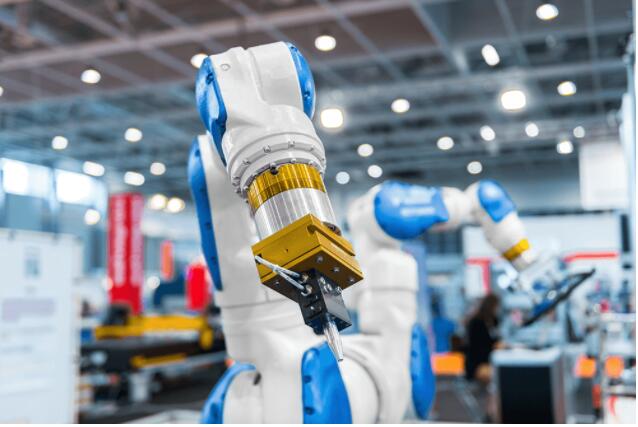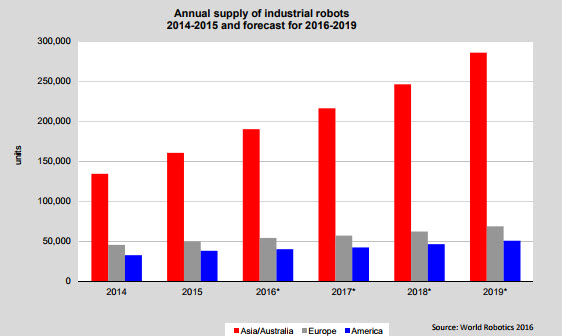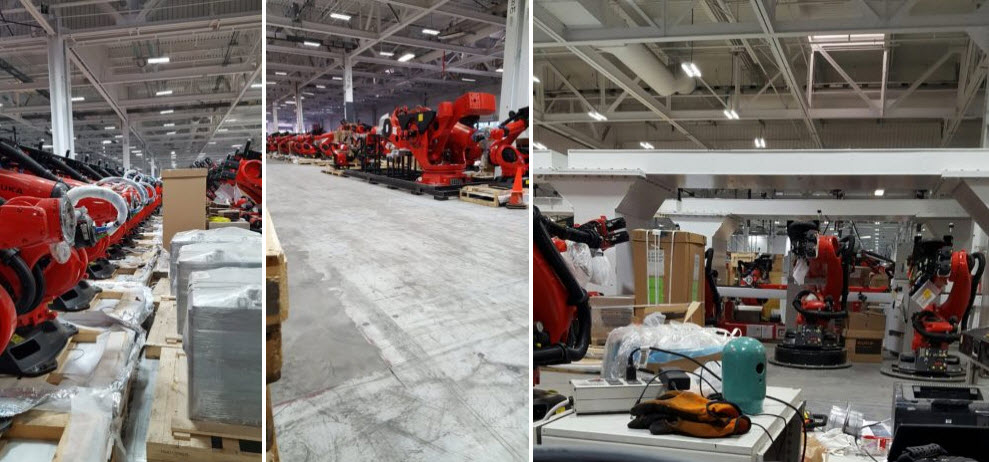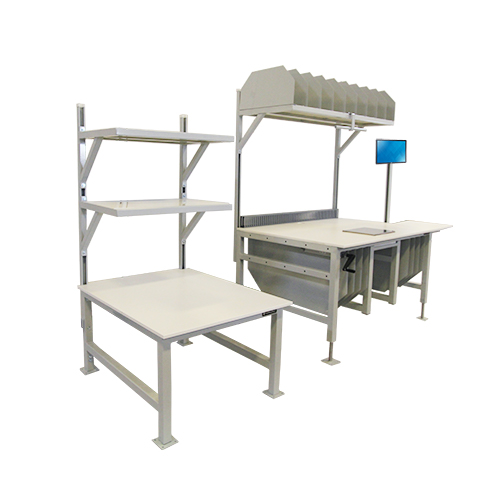2017/08/29 17:28 | Pageview:3770 | From: From FORMASPACE
In an era where “reshoring” overseas manufacturing jobs back home to the USA is on the rise, there’s increasing debate on th
e role of robots in our economy. Will we see a net increase or decrease in overall manufacturing jobs due to robots replacing humans on the factory floor? We take a look at ways you can decide for yourself if investing in industrial automation solutions is the right decision for your industrial facility.

If you like industrial automation technology as much as we do, then the biannual Automate 2017 tradeshow held this past April in Chicago was the place to be. Organized by the Association for Advancing Automation (A3) and its member trade associations, the Robotic Industries Association (RIA), the Motion Control & Motor Association (MCMA), and the Machine Vision Trade Association (AIA), Automate 2017 brought together over 400 robotic companies from around the world to show off their latest advances in robot and industrial automation technology.
(https://www.youtube.com/watch?v=VsHbFTHKpBk)
* One Automate 2017 attendee captured video of the many different styles of working robots on display, ranging from large, dedicated industrial automation systems to smaller robots (known as ‘Co-Bots’) designed to interact safely with people.
Arguments in Favor of Investing in Industrial Automation and Working Robots
The industrial automation business is very hot right now. According to the International Federation of Robotics (IFR), 253,748 industrial robots were sold in 2015 alone (setting a new record). Worldwide industrial robot installations are projected to climb by another 1 million in the next couple of years — projected to reach a total of 2.6 million industrial robots in use by 2019.

Why the sudden burst in sales? Like any other capital investment in manufacturing, the underlying principle is to make a significant return on investment (ROI). Looking at it this way, robots replacing humans is no different than any of the previous leaps in technology that have taken place since the start of the industrial revolution.
Already today’s robots can perform many factory production tasks far faster than human workers — with greater quality and precision. The realized cost savings (in this case, from robots replacing humans) can be significant too: robots don’t need expensive healthcare plans, won’t need old-age pensions, don’t take two-week vacations, and won’t go on strike.
(https://www.youtube.com/watch?v=ym64NFCWORY)
* Working with circuit boards is a delicate operation. Here robots from Kuka (a German Industrial automation company recently acquired by a Chinese conglomerate) show how dedicated working robots can see, touch and manipulate sensitive electronic components on a dedicated assembly line.
Not convinced?
Industrial automation analysts will be watching Tesla Motors closely as it attempts to transform itself from a low-volume (under 100k units per year), high-priced specialty car manufacturer to a high-volume (over 300k units per year), mass market automobile manufacturer. The key to Tesla’s manufacturing strategy appears to be an investment in more than 400 new Kuka robots designed to ramp up production of the upcoming Tesla Model 3, now expected to be available in 2018.

Installing the 467 robots and 21 KL slides for the new Tesla 3 manufacturing plant.
Industrial Automation Advocates Also See Working Robots As Key to Successful Re-Shoring
With robots replacing humans, it’s also becoming economically feasible to move entire factory production lines from low wage regions (such as China or Mexico) back to the USA — an idea that is gathering steam now as the White House promotes the idea of “border adjustment” taxes on imported manufactured goods.
According to the Reshoring Institute’s Reshoring Initiative 2016 Data Report, the year 2016 was significant for American manufacturing. Rather than losing as many as 220,000 manufacturing jobs (as was the case in previous years), the tide turned in 2016 with the first recorded net increase in American manufacturing jobs since the 1970s — thanks to a combined increase in reshoring and foreign direct investment (FDI) in American production facilities.
Wait a Second… With Robots Replacing Humans, Is My Own Job Safe and Secure?
While it may seem a bit off topic, we need to take a moment address an issue that often overshadows any conversation about industrial automation: the question of whether robots will threaten on our own job security.
While robots can make us feel good about reshoring factory production to the USA, they can also make us feel very uneasy about our own individual roles in a robot world. As a result, people often hold conflicting opinions about robots. For example, most of us think it’s a good idea to employ robot workers in dangerous conditions (such as when there is a potential exposure to radiation or toxic chemicals) or to perform inherently risky tasks (such as detecting and detonating bombs). Most (but not all of us) would also agree that robots replacing humans is a suitable choice for highly repetitious and tedious factory jobs (e.g. assembling micro screws into electronic products, such as iPhones). But when it comes to a robot replacing our own job, all of us agree: that’s a BAD idea!
Analysts’ opinion differ on how quickly this could happen, but there is no question that as industrial robots start to learn complex tasks and make decisions on their own (thanks to advances in artificial intelligence), many careers will be at risk, eventually — even some surprising ones, such as jobs for music composers creating soundtracks for videos.
Technology analyst, Shelly Palmer, predicts that the five jobs most vulnerable to robot replacement are:
• Middle Managers
• Commodity Salespeople
• Report Writers, Journalists, Authors, & Announcers
• Accountants and Bookkeepers
• Doctors
While he predicts the least at-risk professions are:
• Pre-school and Elementary School Teachers
• Professional Athletes
• Politicians
• Judges
• Mental Health Professionals
Facebook founder, Mark Zuckerberg, recently predicted that job displacement by automation will be one of the major challenges facing the Millennial Generation. Speaking at Harvard University (where he received an honorary degree), Zuckerberg speculated we might need to “explore ideas like universal basic income…” as a means to cope with the coming changes facing society.

Referring to recent tweet exchange between Elon Musk and Mark Zuckerberg where Tesla CEO calls Facebook founder’s understanding of AI “limited”!
Famed British scientist, Stephen Hawking, sees a much darker future, warning us that we’re on a path toward a Robot Apocalypse where artificial intelligence (AI) life forms take over. The resulting “AI Takeover” sounds almost as bad as a Zombie Apocalypse, except, instead of being killed by the walking dead, we’ll suffer a similar fate as space explorers David Bowman and Frank Poolethe in the film 2001: A Space Odyssey at the hands of the all-powerful HAL 9000 computer.
The Counter Argument: Investments in Industrial Automation Will Create More Jobs Overall
Does it all have to be that dire?
When it when comes to robots replacing humans, are we playing a zero-sum game? They win, we lose?
In other words, each time a robot is deployed on a factory floor, do we just count the immediate job losses — without measuring any other potential positive effect on the economy?
Many economists think the zero-sum approach is the wrong way to look at it. They make the argument that — despite losing some jobs to automation in the short term — the increase in productivity derived from implementing working robots will help our overall economy grow faster, which, in turn, will create more, higher quality jobs than we had before. The resulting higher standards of living we achieve as a result will lead to even more progress as we go forward.
That’s the view of the Association for Advancing Automation (A3) in their white paper called “Work in the Automation Age,” which makes a case that significant job growth is tied to the introduction of new jobs categories brought about by advances in technology.
Should You Invest in Robotic Industrial Automation at Your Facility?
How should managers in industrial manufacturing facilities proceed?
If you haven’t already embarked on your own industrial automation programs (in that case, we’d like to hear from you about your experiences!), then a good place to start is to define your requirements.
Does your production facility have highly predictable tasks that have been successfully automated by a commercial robot vendor at other locations, such as at a competitor for example? Dangerous tasks (including ones that require heavy lifting) and boring/repetitive tasks make good candidates for automation. If so, it’s now fairly straightforward to perform the necessary due diligence to see if a robotic system (e.g. robots replacing humans) would provide sufficient return on investment during a reasonable timeframe.
(https://www.youtube.com/watch?v=c3GZ2Q0QLP8)
* Škoda Auto (part of the Volkswagen Group), MATADOR and KUKA have implemented a fence-free robotic system that automates a very precise task — inserting gear actuator pistons into automatic transmissions assemblies produced at the factory.
Another question to ask yourself is how much interaction between robot workers and humans is desirable.
For production lines that run consistently at high volumes with very few running design changes, the most cost-effective choice over the long haul (say 8 or 10 years) might be to implement a comprehensive, high-speed automation system that’s completely isolated from human workers by a safety fence or cage.
On the other hand, if you manufacture short runs of many different products, or if your overall volume is small, you might want to investigate robots designed to work directly with humans on the factory floor. Known as Co-Bots, these worker robots incorporate built-in safety features (such as stopping when touched) that allow them to work side-by-side with people.
This latter approach also has the advantage of allowing you to start small and gain hands-on experience before making further investments.
TIP: If you have a small budget, Baltimore-based startup, Ready Robot, will rent its TaskMate robot for a few thousand dollars per month.
Why You Might Not Want Robots Replacing Humans at Your Industrial Facility
On the other hand, there are quite a few reasons why you might NOT want robots replacing humans in your factory anytime soon.
These include:
• A strong philosophical belief against robots replacing humans
• Product lines that are valued for their one-of-a-kind, hand-made, artisanal craftsmanship
• Concerns about negative ‘optics’ in the marketplace, e.g. the impact that unfavorable publicity about replacing workers would have on reputation and goodwill
• Existing government tax incentives to hire workers
• Disruptions in labor negotiations with unions and other worker groups
• Cost and complexity of training robots to do useful tasks
• Inability to find enough well-educated workers with the necessary skills to support a technology-driven, robot-powered production line. (Creating an apprentice program may be the answer)
• Concerns about technological obsolescence, e.g. is it better to wait for the next generation of robots before investing
• Custom-made or specialized product designs that do not lend themselves to robot automation at this time
• Lack of available investment capital to make changes
What is the Best Way to Determine an Industrial Automation Strategy for Your Facility?
Looking for a way forward? Here are some practical suggestions on how to organize a new industrial automation program at your facility:
• Join one or more of the industrial automation and trade groups listed above
• Research industry best practices, including what your closest competitors are doing
• Identify reliable partners to work with. (Hopefully, you will include Formaspace as we provide custom American-made industrial furniture systems to Fortune 500 companies, including some of the world’s most highly-automated manufacturing and warehousing facilities.)
• Get people, including factory workers, involved early in the decision-making process
• Define your automation goals in the short and long term
• Cost different scenarios in order to identify which approaches offer the best potential ROI
• Establish a pilot program before committing to a major investment
Make the Right Connection with Formaspace
Want to know more? Get in touch with your Formaspace Design Consultant. Just fill out the short form below to get started.

Packing Station w/ Robot Hosting Sister Bench
As a furniture supplier to Fortune 100 and 500 companies, we have the experience to help you make your factory more efficient. We can help across the board — from creating elegant, industrial-look desks and conference tables for your public spaces and private offices, to building strong, durable, efficient industrial-grade workstations built to withstand heavy use on the factory floor or in laboratory settings, to custom-designed packing stations to make your shipping and warehousing departments more efficient than ever.
